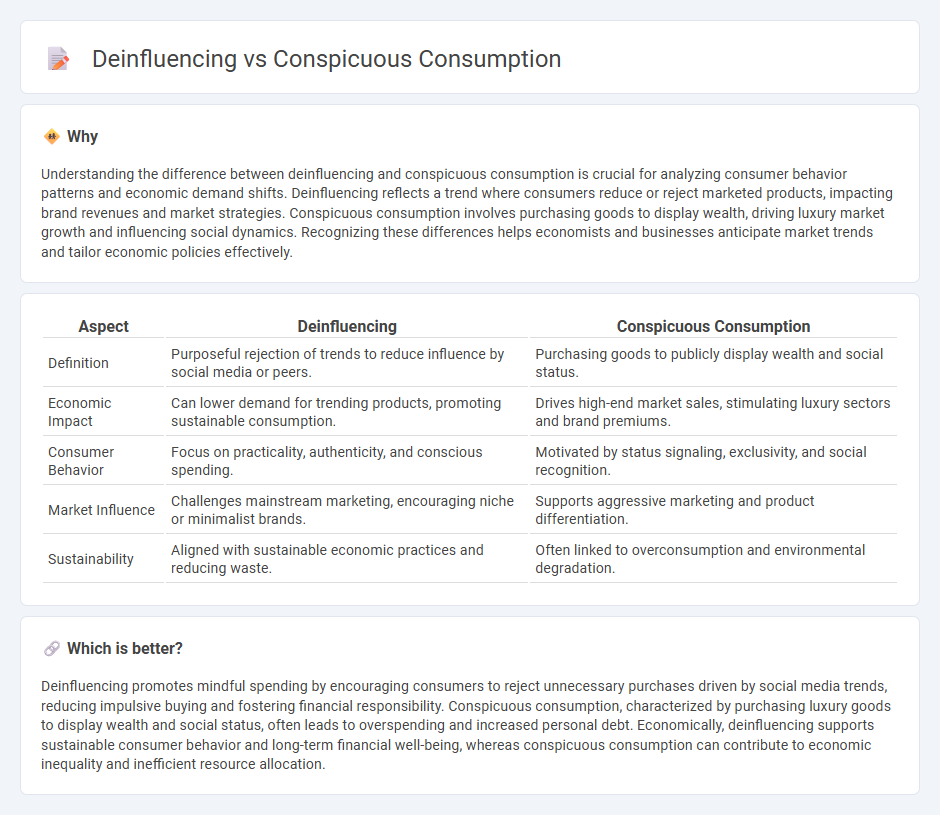
Deinfluencing challenges traditional patterns of conspicuous consumption by promoting mindful purchasing decisions and reducing the emphasis on material display as a status symbol. This shift impacts economic behaviors by encouraging sustainability and altering market demand toward products that emphasize value over appearance. Explore further to understand how these trends reshape consumer economies globally.
Why it is important
Understanding the difference between deinfluencing and conspicuous consumption is crucial for analyzing consumer behavior patterns and economic demand shifts. Deinfluencing reflects a trend where consumers reduce or reject marketed products, impacting brand revenues and market strategies. Conspicuous consumption involves purchasing goods to display wealth, driving luxury market growth and influencing social dynamics. Recognizing these differences helps economists and businesses anticipate market trends and tailor economic policies effectively.
Comparison Table
| Aspect | Deinfluencing | Conspicuous Consumption |
|---|---|---|
| Definition | Purposeful rejection of trends to reduce influence by social media or peers. | Purchasing goods to publicly display wealth and social status. |
| Economic Impact | Can lower demand for trending products, promoting sustainable consumption. | Drives high-end market sales, stimulating luxury sectors and brand premiums. |
| Consumer Behavior | Focus on practicality, authenticity, and conscious spending. | Motivated by status signaling, exclusivity, and social recognition. |
| Market Influence | Challenges mainstream marketing, encouraging niche or minimalist brands. | Supports aggressive marketing and product differentiation. |
| Sustainability | Aligned with sustainable economic practices and reducing waste. | Often linked to overconsumption and environmental degradation. |
Which is better?
Deinfluencing promotes mindful spending by encouraging consumers to reject unnecessary purchases driven by social media trends, reducing impulsive buying and fostering financial responsibility. Conspicuous consumption, characterized by purchasing luxury goods to display wealth and social status, often leads to overspending and increased personal debt. Economically, deinfluencing supports sustainable consumer behavior and long-term financial well-being, whereas conspicuous consumption can contribute to economic inequality and inefficient resource allocation.
Connection
Deinfluencing reduces the impact of social media endorsements by promoting authenticity and skepticism, which challenges the excessive purchasing driven by conspicuous consumption. Conspicuous consumption manifests in buying luxury goods to signal wealth and status, fueling consumer demand that deinfluencing seeks to moderate. Understanding the dynamic between these trends reveals shifts in consumer behavior affecting market economies and brand marketing strategies.
Key Terms
Social Status
Conspicuous consumption involves purchasing expensive goods to display wealth and elevate social status, reinforcing social hierarchies through material possessions. Deinfluencing counters this trend by promoting mindful consumption and rejecting status-driven buying behaviors, emphasizing authenticity and personal values over external validation. Explore the impact of these contrasting behaviors on social status dynamics and consumer culture.
Consumer Behavior
Conspicuous consumption involves consumers purchasing luxury goods to showcase status and wealth, reflecting a desire for social recognition and identity signaling. Deinfluencing, by contrast, advocates for minimalism and mindful consumption, encouraging consumers to resist social pressures and avoid unnecessary purchases driven by trends. Explore the evolving dynamics of consumer behavior by examining how these opposing forces shape purchasing decisions.
Anti-consumption
Conspicuous consumption involves purchasing goods to display wealth and status, while deinfluencing promotes rejecting materialistic trends to reduce unnecessary spending. Anti-consumption emphasizes minimalism, sustainability, and mindful consumption as a response to the social pressures of conspicuous consumption. Explore how anti-consumption reshapes consumer behavior and challenges modern marketing strategies.
Source and External Links
24 Conspicuous Consumption Examples (2025) - Conspicuous consumption is the purchase and display of luxury goods to flaunt wealth and social status, driven by a desire to impress others rather than utility, often perpetuating social inequality and materialism.
Veblen's Theory of Conspicuous Consumption - Introduced by economist Thorstein Veblen, the theory explains conspicuous consumption as buying luxury goods to demonstrate social status and wealth, driven by social recognition rather than necessity.
Conspicuous consumption - Wikipedia - This concept involves buying expensive, non-essential goods in a noticeable way to display wealth, including examples such as luxury fashion, and extends to related behaviors like conspicuous compassion.
 dowidth.com
dowidth.com